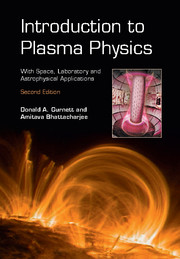Book contents
- Frontmatter
- Dedication
- Contents
- Preface
- 1 Introduction
- 2 Characteristic Parameters of a Plasma
- 3 Single-Particle Motions
- 4 Waves in a Cold Plasma
- 5 Kinetic Theory and the Moment Equations
- 6 Magnetohydrodynamics
- 7 MHD Equilibria and Stability
- 8 Discontinuities and Shock Waves
- 9 Electrostatic Waves in a Hot Unmagnetized Plasma
- 10 Waves in a Hot Magnetized Plasma
- 11 Nonlinear Effects
- 12 Collisional Processes
- Appendix A Symbols
- Appendix B Useful Trigonometric Identities
- Appendix C Vector Differential Operators
- Appendix D Vector Calculus Identities
- Index
- References
3 - Single-Particle Motions
Published online by Cambridge University Press: 16 March 2017
- Frontmatter
- Dedication
- Contents
- Preface
- 1 Introduction
- 2 Characteristic Parameters of a Plasma
- 3 Single-Particle Motions
- 4 Waves in a Cold Plasma
- 5 Kinetic Theory and the Moment Equations
- 6 Magnetohydrodynamics
- 7 MHD Equilibria and Stability
- 8 Discontinuities and Shock Waves
- 9 Electrostatic Waves in a Hot Unmagnetized Plasma
- 10 Waves in a Hot Magnetized Plasma
- 11 Nonlinear Effects
- 12 Collisional Processes
- Appendix A Symbols
- Appendix B Useful Trigonometric Identities
- Appendix C Vector Differential Operators
- Appendix D Vector Calculus Identities
- Index
- References
Summary
A complete mathematical model of a plasma requires three basic elements: first, the motion of all particles must be determined for some assumed electric and magnetic field configuration; second, the current and charge densities must be computed from the particle trajectories; and third, the electric and magnetic fields must be self-consistently determined from the currents and charges, taking into account both internal and external sources. To be self-consistent, the electric and magnetic fields obtained from the last step must correspond to the fields used in the first step. It is this self-consistency requirement that makes the analysis of a plasma difficult.
To develop an understanding of the processes occurring in a plasma, a useful first step is to forget about the self-consistency requirement and concentrate on the motion of a single particle in a specified field configuration. This approach can be useful in a variety of situations. If the external fields are very strong and the plasma is sufficiently tenuous, the internally generated fields are sometimes small and can be safely ignored. This situation arises, for example, in radiation belts at high energies and in various electronic devices such as vacuum tubes and traveling wave amplifiers. In other situations, the self-consistent electric and magnetic fields may be known from direct measurement. In this case, it is often useful to follow the motion of individual tracer particles in the known electric and magnetic fields in order to gain insight into the physical processes involved, such as particle transport and energization. Finally, in some cases it is possible to use the general solution for the particle motion in an assumed field geometry to determine a fully self-consistent solution in which the currents and charges produce the assumed fields.
Motion in a Static Uniform Magnetic Field
The simplest field configuration of importance in plasma physics is a static uniform magnetic field. The equation of motion for a particle moving at non-relativistic velocities in a static uniform magnetic field is given by
where q(v×B) is the Lorentz force.
- Type
- Chapter
- Information
- Introduction to Plasma PhysicsWith Space, Laboratory and Astrophysical Applications, pp. 22 - 86Publisher: Cambridge University PressPrint publication year: 2017



